The Top 20 Most Bizarre Experiments
of All Time
by Alex Boese
of All Time
by Alex Boese
I originally wrote this list to help publicize my book Elephants on Acid, by offering a sample of the kind of content it included — that content being accounts of strange and bizarre scientific experiments that actually have been conducted. An adapted version of the list was later published in New Scientist magazine (Oct 31, 2007).
Are these really the most bizarre experiments of all time? Who knows. A more accurate title might be, "Twenty very bizarre experiments that in 2007 I thought were particularly good examples of the genre." But that's not as catchy.
Elephants on Acid is part of my 'weird science' book series that also includes Electrified Sheep and Psychedelic Apes.
Are these really the most bizarre experiments of all time? Who knows. A more accurate title might be, "Twenty very bizarre experiments that in 2007 I thought were particularly good examples of the genre." But that's not as catchy.
Elephants on Acid is part of my 'weird science' book series that also includes Electrified Sheep and Psychedelic Apes.

#1: Elephants on Acid
Warren Thomas, Director of the City Zoo, fired a cartridge-syringe containing 297 milligrams of LSD into Tusko the Elephant's rump. With Thomas were two scientific colleagues from the University of Oklahoma School of Medicine, Louis Jolyon West and Chester M. Pierce.
297 milligrams is a lot of LSD. It's about 3000 times the level of a typical human dose. In fact, it remains the largest dose of LSD (that we know of) ever given to a living creature. The researchers figured that, if they were going to give an elephant LSD, they better not give him too little since they knew that elephants are highly resistant to many drugs.
Thomas, West, and Pierce later explained that the experiment was designed to find out if LSD would induce musth in an elephant. Musth is a kind of temporary madness male elephants sometimes exhibit during which they become highly aggressive and secrete a sticky fluid from their temporal glands. But one suspects a small element of ghoulish curiosity might also have been involved.
Whatever the reason for the experiment, it almost immediately went awry. Tusko reacted to the shot as if a bee had stung him. He trumpeted around his pen for a few minutes, and then keeled over on his side. Horrified, the researchers tried to revive him with antipsychotics, but about an hour later he was dead. The three scientists sheepishly concluded, "It appears that the elephant is highly sensitive to the effects of LSD."
In the years that followed controversy lingered over whether it was the LSD that killed Tusko, or the antipsychotics used in the attempt to revive him. So twenty years later, Ronald Siegel of UCLA decided to settle the debate by giving two elephants a dose similar to what Tusko received. Reportedly he had to sign an agreement promising to replace the animals in the event of their deaths.
Instead of injecting the elephants with LSD, Siegel mixed the drug into their water, and when it was administered in this way, the elephants not only survived but didn't seem too upset at all. They acted sluggish, rocked back and forth, and made some strange vocalizations such as chirping and squeaking, but within a few hours they were back to normal. However, Siegel noted that the dosage Tusko received may have exceeded some threshold of toxicity, so he couldn't rule out that LSD was the cause of his death. The controversy continues.
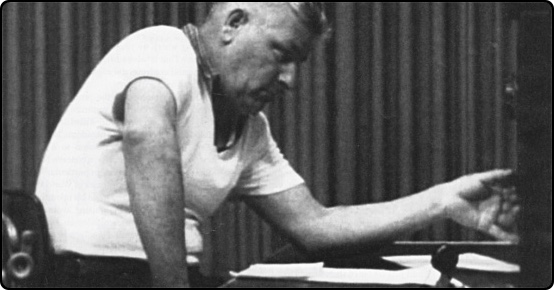
#2: The Obedience Experiment
When asked what they would do in such a situation, almost everyone replies that of course they would refuse to commit murder. But Stanley Milgram's famous obedience experiment, conducted at Yale University in the early 1960s, revealed that this optimistic belief is wrong. If the request is presented in the right way, almost all of us quite obediently become killers.
Milgram told subjects they were participating in an experiment to determine the effect of punishment on learning. One volunteer (who was, in reality, an actor in cahoots with Milgram) would attempt to memorize a series of word pairs. The other volunteer (the real subject) would read out the word pairs and give the learner an electric shock every time he got an answer wrong. The shocks increased in intensity by fifteen volts with each wrong answer.
The experiment began. The learner eventually got some answers wrong, and then some more, and soon the shocks had reached 120 volts. At this point the learner started crying out, "Hey, this really hurts." At 150 volts the learner screamed in pain and demanded to be let out. Confused, most volunteers turned around and asked the researcher what they should do. The researcher always calmly replied, "The experiment requires that you continue."
Milgram actually had no interest in the effect of punishment on learning. What he really wanted to see was how long people would keep pressing the shock button before they refused to participate in the increasingly sadistic experiment. Would they remain obedient to the authority of the researcher up to the point of killing someone?
To Milgram's surprise, even though volunteers could plainly hear the agonized cries of the learner echoing through the walls of the lab from the neighboring room, two-thirds of them continued to press the shock button all the way up to the end of scale, 450 volts, by which time the learner had fallen into an eerie silence, apparently dead. Milgram's subjects sweated and shook, and some laughed hysterically, but they kept pressing the button. Even more disturbingly, when volunteers could neither see nor hear feedback from the learner, compliance with the order to give ever greater shocks was almost 100%.
Milgram later commented, "I would say, on the basis of having observed a thousand people in the experiment and having my own intuition shaped and informed by these experiments, that if a system of death camps were set up in the United States of the sort we had seen in Nazi Germany, one would be able to find sufficient personnel for those camps in any medium-sized American town."
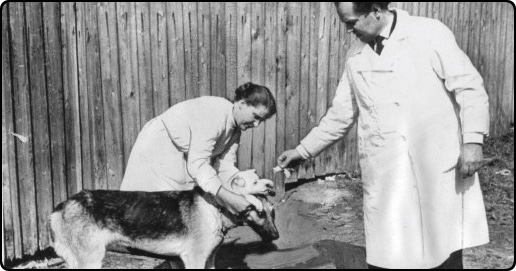
#3: Demikhov’s Two-Headed Dogs
Demikhov paraded the dog before reporters from around the world. Journalists gasped as both heads simultaneously lapped at bowls of milk, and then cringed as the milk from the puppy's head dribbled out the unconnected stump of its esophageal tube. The Soviet Union proudly boasted that the dog was proof of their nation's medical preeminence.
Over the course of the next fifteen years, Demikhov created a total of twenty of his two-headed dogs. None of them lived very long, as they inevitably succumbed to problems of tissue rejection. The record was a month.
Demikhov explained that the dogs were part of a continuing series of experiments in surgical techniques, with his ultimate goal being to learn how to perform a human heart and lung transplant. Another surgeon beat him to this goal Dr. Christian Baarnard in 1967 but Demikhov is widely credited with paving the way for it.
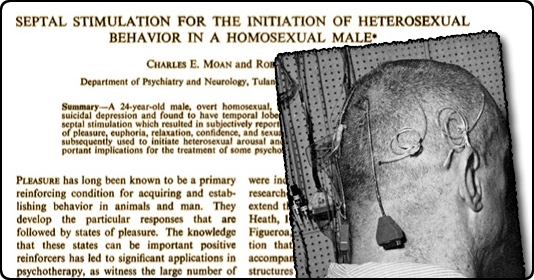
#4: The Initiation of Heterosexual Behavior in a Homosexual Male
In 1970, Robert Heath of Tulane University dreamed up a far more novel application of Olds and Milner's discovery. Heath decided to test whether repeated stimulation of the septal region could transform a homosexual man into a heterosexual.
Heath referred to his homosexual subject as patient B-19. He inserted Teflon-insulated electrodes into the septal region of B-19's brain and then gave B-19 carefully controlled amounts of stimulation in experimental sessions. Soon the young man was reporting increased stirrings of sexual motivation. Heath then rigged up a device to allow B-19 to self-stimulate himself. It was like letting a chocoholic loose in a candy shop. B-19 quickly became obsessed with the pleasure button. In one three-hour session he pressed it 1500 times until, as Heath noted, "he was experiencing an almost overwhelming euphoria and elation and had to be disconnected."
By this stage of the experiment B-19's libido was so jacked up that Heath decided to proceed with the final stage in which B-19 would be introduced to a sexually-willing female partner. With permission from the state attorney general, Heath arranged for a twenty-one-year-old female prostitute to visit the lab, and he placed her in a room with B-19. For an hour B-19 did nothing, but then the prostitute took the initiative and a successful sexual encounter between the two occurred. Heath considered this a positive result.
Little is known of B-19's later fate. Heath reported that the young man drifted back into a life of homosexual prostitution, but that he also had an affair with a married woman. Heath optimistically decided that this showed the treatment was at least partially successful. However, Heath never did try to convert any more homosexuals.
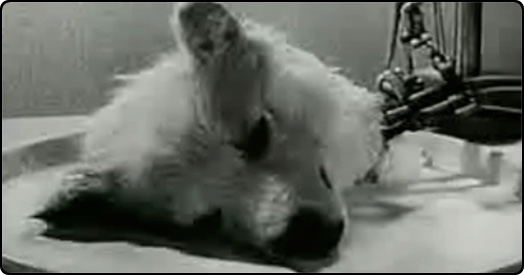
#5: The Isolated Head of a Dog
Soviet physician Sergei Brukhonenko developed a primitive heart-lung machine he called an "autojector," and with this device he succeeded in keeping the severed head of a dog alive. He displayed one of his living dog heads in 1928 before an international audience of scientists at the Third Congress of Physiologists of the USSR. To prove that the head lying on the table really was alive, he showed that it reacted to stimuli. Brukhonenko banged a hammer on the table, and the head flinched. He shone light in its eyes, and the eyes blinked. He even fed the head a piece of cheese, which promptly popped out the esophageal tube on the other end.
Brukhonenko's severed dog head became the talk of Europe and inspired the playwright George Bernard Shaw to muse, "I am even tempted to have my own head cut off so that I can continue to dictate plays and books without being bothered by illness, without having to dress and undress, without having to eat, without having anything else to do other than to produce masterpieces of dramatic art and literature."
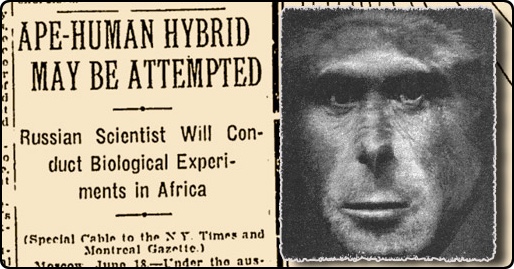
#6: Human-Ape Hybrid
Dr. Il'ya Ivanov was a world-renowned expert on veterinary reproductive biology, but he wanted to do more in life than breed fatter cows. So in 1927 he traveled to Africa to pursue his vision of interbreeding man and ape.
Thankfully his efforts weren't successful. This was due both to genetics, and to the native staff of the West Guinea research facility where he worked, from whom he constantly had to conceal the true purpose of his experiments. If they had found out what he was really doing, he wrote in his diary, "this could have led to very unpleasant consequences." The necessity of carrying out his work in secrecy made it almost impossible to do anything, although he did record two unsuccessful attempts to artificially inseminate female chimpanzees with human sperm.
Frustrated, Ivanov eventually returned to the Soviet Union. He brought an orangutan named Tarzan back with him, hoping to continue his research in a more accepting environment. Back home he advertised for female volunteers willing to carry Tarzan's child, and remarkably he got a few takers. But then Tarzan died and Ivanov himself, suspected of harboring counter-revolutionary sentiments, was sent off to a prison camp for a couple of years. This ended his research. There are vague rumors suggesting that other Soviet scientists continued Ivanov's work, but nothing has been proven.
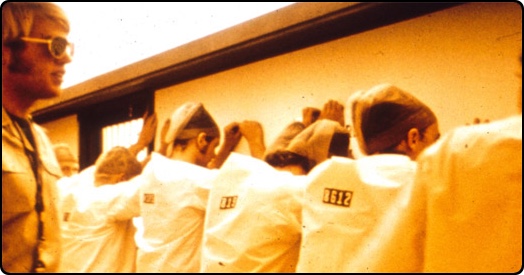
#7: The Stanford Prison Experiment
Determined to find an answer, Philip Zimbardo created a mock prison in the basement of the Stanford psychology department. He recruited clean-cut young men as volunteers — none had criminal records and all rated "normal" on psychological tests — and he randomly assigned half of them to play the role of prisoners and the other half to play guards. His plan was that he would step back for two weeks and observe how these model citizens interacted with each other in their new roles.
What happened next has become the stuff of legend.
Social conditions in the mock prison deteriorated with stunning rapidity. On the first night the prisoners staged a revolt, and the guards, feeling threatened by the insubordination of the prisoners, cracked down hard. They began devising creative ways to discipline the prisoners, using methods such as random strip-searches, curtailed bathroom privileges, verbal abuse, sleep deprivation, and the withholding of food.
Under this pressure, prisoners began to crack. The first one left after only thirty-six hours, screaming that he felt like he was "burning up inside." Within six days, four more prisoners had followed his lead, one of whom had broken out in a full-body stress-related rash. It was clear that for everyone involved the new roles had quickly become more than just a game.
Even Zimbardo himself felt seduced by the corrosive psychology of the situation. He began entertaining paranoid fears that his prisoners were planning a break-out, and he tried to contact the real police for help. Luckily, at this point Zimbardo realized things had gone too far. Only six days had passed, but already the happy college kids who had begun the experiment had transformed into sullen prisoners and sadistic guards.
Zimbardo called a meeting the next morning and told everyone they could go home. The remaining prisoners were relieved, but tellingly, the guards were upset. They had been enjoying their new-found power and had no desire to give it up.
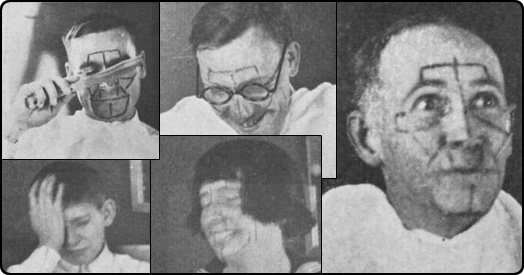
#8: Facial expressions while decapitating a rat
Most of Landis's subjects were fellow graduate students. He brought them into his lab and painted lines on their faces so that he could more easily see the movement of their muscles. He then exposed them to a variety of stimuli designed to provoke a strong psychological reaction. As they reacted, he snapped pictures of their faces. He made them smell ammonia, look at pornographic pictures, and reach their hand into a bucket containing slimy frogs. But the climax of the experiment arrived when he carried out a live white rat on a tray and asked them to decapitate it.
Most people initially resisted his request, but eventually two-thirds did as he ordered. Landis noted that most of them performed the task quite clumsily: "The effort and attempt to hurry usually resulted in a rather awkward and prolonged job of decapitation." For the one-third that refused, Landis eventually picked up the knife and decapitated the rat for them.
Landis's experiment presented a stunning display of the willingness of people to obey the demands of experimenters, no matter how bizarre those demands might be. It anticipated the results of Milgram's obedience experiment by almost forty years. However, Landis never realized that the compliance of his subjects was far more interesting than their facial expressions. Landis remained single-mindedly focused on his initial research topic. However, he never was able to match up emotions and expressions. It turns out that people use a wide variety of expressions to convey the same emotion — even an emotion such as disgust at having to decapitate a rat.
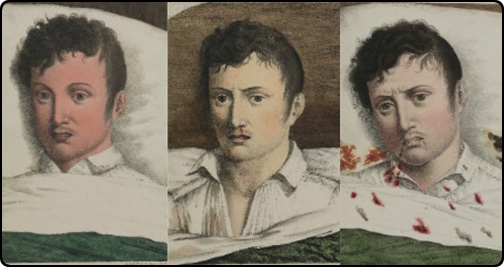
#9: The Vomit-Drinking Doctor
But what good is a theory without proof? To get that proof, Ffirth designed a heroic self-experiment. He set out to demonstrate that no matter how much he exposed himself to yellow fever, he wouldn't catch it.
He started by making small incisions on his arms and pouring "fresh black vomit" obtained from a yellow-fever patient into the cuts. He didn't get sick.
Next he dribbled some vomit in his eyes. He fried some up on a skillet and inhaled the fumes. He fashioned some into a pill and swallowed it. Finally he took to drinking entire glasses of pure, undiluted black vomit. And still he didn't get sick.
Ffirth rounded out his experiment by liberally smearing himself with other yellow-fever tainted fluids: blood, saliva, perspiration, and urine. Healthy as ever, he declared his theory proven. Unfortunately, he was wrong. Yellow fever is actually very contagious, but it requires direct transmission into the blood stream, usually by a mosquito, to cause infection. But considering all Ffirth did to infect himself, it is a bit of a miracle he remained alive.
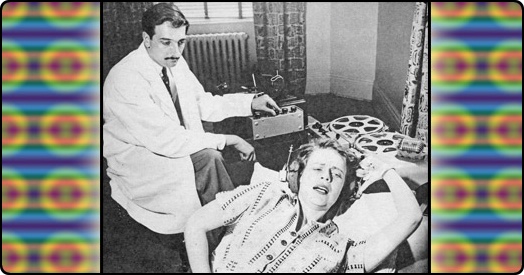
#10: Beneficial Brainwashing
During the 1950s and early 1960s, hundreds of Cameron's patients at Montreal's Allan Memorial Clinic became his unwitting test subjects — whether or not they actually had schizophrenia. Some patients checked in complaining of problems as minor as menopause-related anxiety, only to find themselves sedated with barbiturates, strapped into a bed, and forced to listen for days on end to messages such as "People like you and need you. You have confidence in yourself."
One time, to test the technique, Cameron placed patients into a drugged sleep and made them listen to the message, "When you see a piece of paper, you want to pick it up." Later he drove them to a local gymnasium. There, lying in the middle of the gym floor, was a single piece of paper. He happily reported that many of them spontaneously walked over to pick it up.
When the CIA learned of what Cameron was doing, it became interested and started surreptitiously channeling him money. But eventually the agency concluded that Cameron's technique was a failure and cut his funding, prompting Cameron himself to admit that his experiments had been "a ten year trip down the wrong road." In the late 1970s a group of Cameron's former patients filed suit against the CIA for its support of his work and reached an out-of-court settlement for an undisclosed amount of money.

